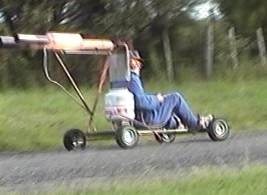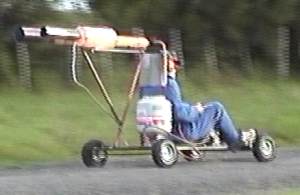Jet engine technologies for interested amateurs
Last Updated: 21 September, 2003
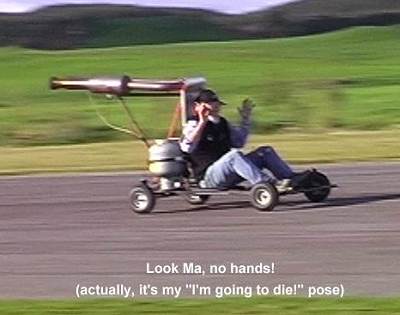
Today I fired up the GPS and onboard microcontroller along with the wireless video camera, and took the kart for a spin down a long straight, sealed track.
I did a U-turn and came back the other way to make 56mph over the same distance. Unfortunately the transmitter for the onboard video didn't like the vibration of the pulsejet and blew an output transistor when the antenna connector came loose and fell off before I even started moving :-( If I can find a replacement in my junk-box I'll fix it and try again this weekend if the weather's fine. Based on today's run, I would estimate that the jet-kart has a top speed of possibly 70mph -- but not with these wheels!
Note that the video camera being used was a high-quality 3CCD unit which isn't over-sensitive to infrared like cheaper single-CCD cameras.
As a result, even though the engine is still running red-hot, it doesn't
show up as such in the bright daytime lighting when filmed with this camera.
The pictures below of the kart in action however, were taken with a single-CCD camera.
New Vids Coming!
As soon as the weather clears, I'll take the kart for a run and record footage from this onboard system which will be uploaded to the site. I'll also be able to provide an truely accurate speed because I'll be carrying the onboard flight-control system from the missile which has a GPS. Let's hope the fine weather is not too far away.
I've edited down some of the video footage of the Jet-kart in action and uploaded them to this site. They're in MPEG format so should play on any computer. This seven-second clip (360K)shows the cart bouncing along my bumpy unsealed road at around 50 KPH (30 MPH). My foot is on the brake because I'm chicken! It's easy to see why my neighbors love me eh? This clip (410K) shows what happens when the propane tank runs dry just as I'm coming out of my driveway and passing under a tree -- poor tree!
The powerplant I built this engine to act as a benchmark to use when comparing my own ideas to those of a known design. For more information on, and pictures of this engine, check out this page.
The Kart The high-mounting system made it a piece of cake to drop the new engine into the kart with only a couple of extra holes being drilled. There are many advantages to be had from mounting the engine as high as it is. Since heat rises, it means that the rest of the kart (including the fuel-tank and driver) remain unaffacted by the massive amount of heat generated when the engine is in operation.
The Fuel System Once again, that high-mounted engine means that there's plenty of room on the kart to carry the tank. In fact, since I only get about 4 minutes of useful engine run out of a 20lb fuel tank, I'm planning to add another tank on the other side for when I want to drive a little further afield.
Performance I've only had the kart up to about 30mph with this engine but it was still accelerating and I'm sure it would be good for another 20-30 mph if I had a slightly longer stretch of somewhat smoother road to use. You'll note that the road I'm using has a slight uphill incline which actually makes a huge difference (coming back down is really scary because the kart picks up speed so much more quickly).
|
|

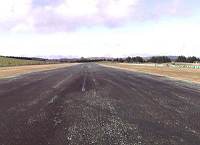 According to the GPS, the top speed reached during the run was 57mph, and it
was still accelerating but the vibration from those unbalanced trolley wheels
was just getting a little too violent for safety. It took around 300 yards
to reach this speed.
According to the GPS, the top speed reached during the run was 57mph, and it
was still accelerating but the vibration from those unbalanced trolley wheels
was just getting a little too violent for safety. It took around 300 yards
to reach this speed.
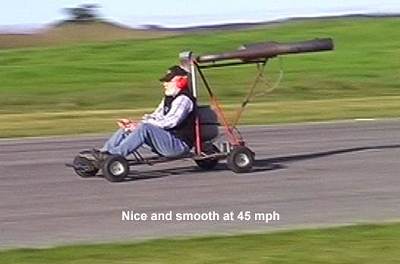 Here's a frame captured from a video a friend took of the kart shortly after the
speed runs. Unfortunately most of the footage is too jerky and badly filmed
to bother converting to MPEG but I'll take some more video footage as soon
as time allows.
Here's a frame captured from a video a friend took of the kart shortly after the
speed runs. Unfortunately most of the footage is too jerky and badly filmed
to bother converting to MPEG but I'll take some more video footage as soon
as time allows.
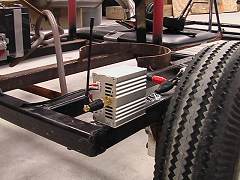

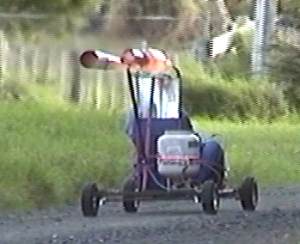 The Lockwood runs on liquid LPG/propane and as you can see, I'm using
a regular 20lb BBQ tank which I've inverted and mounted directly behind
the driver's seat.
The Lockwood runs on liquid LPG/propane and as you can see, I'm using
a regular 20lb BBQ tank which I've inverted and mounted directly behind
the driver's seat.
